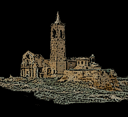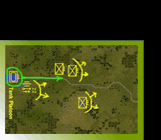 |
 |
||||
 |
||||
|
Title: Villalba dels Arcs (Villalba de los Arcos) Note: German as Nationalist, French&British as Republican Author: Mario Gomez "Magomar" Descarga: [Scenario Depot] ------------------------------------------------------------------ "The first day of the Ebro offensive (July, 25) had ended extremely well for the Rebuplicans; apart from Mora de Ebro, the 70km front, which had been held by the Nationalist, had collapsed. The 35th Division was on the edge of Gandesa, the 3rd Division was in the Sierra de la Fatarella and the 11th was well established in the Sierra de Pàndols. More importantly, the iron bridge at Flix was being completed, as was the wooden bridge at Ascó, both of which would allow the free flow of traffic. In Ginestar and Benifallet, wooden "puentes de vanguardia" had been built. Many of the attacks on the Nationalist side of the river were conducted without the support of armor, which could not be transported until heavy bridges had been constructed. At this point, Tagüeña, XV Corps' commander, ordered the 16th Division to cross the river, but he was countermanded by General Rojo. With the emphasis on speed, it is difficult to know why this decision was taken but it obviously slowed down the offensive, and this was to have serious consequences. During the night the Nationalists worked at fever pitch to get reinforcements into the area.The next day, 26 July, would be crucial for the success or failure of the attack. Although the advance continued, in reality all efforts would be expended on the struggle for the river crossings. As soon as first light illuminated the river valley aircraft was on in the air. The lack of Republican air upport at this critical stage was strange, and bring the Nationalist the air superiority. Many of the armored vehicles and supply trucks needed on the other side of the river waited at Vinebre, but crossing was severely curtailed at Ascó, when a munitions truck ran into one of the support stanchions and severely damaged the bridge. Raft ferries were able to take some of the transport, but the slowness with which the vehicles were able to cross must have been agonising for the commanders. As the morning wore on, successive air attacks began to plague the river crossings. Although there was some antiaircraft protection, the battle became one of engineers against aviators. If a bridge was damaged by air attack it had to be repaired in the face of further bombing and strafing. To add insult to injury, the opening of flood gates at Tremp and Camarasa meant that the level of the river rose further, causing severe problems for the attackers. The river would continue to rise until 27 July."
The 131st Battalion of the 33rd Mixed Brigade occupied the cemetery opposite the walled village. The unit had to leave its tank support behind because of damage to the bridge crossing. The frontal attack on the village began at 11:00 but failed at 13:00 due to the height advantage of the defenders and so the attackers retired to the cemetery. Nationalist Teniente Coronel Capablanca, installed within the town, ordered a succesful counter attack in which the 18th Bandera and reorganised companiestook part. They were supported by machinegun crossfire, nevertheless the situation remained fluid. A second Republican attack on the evening of the 26th put the cemetery back in the hand of the attackers and the Nationalists were forced to retreat into the town, where they begin to dig in. The 31st Mixed Brigade took the important Hill 481 dominating Quatre Camins and was charged with attacking frontally. 29th July, units from the 74th Division got into the area, turning the force balance favorable to the Nationalist, which began to counter-attack around the Faristol hill, captured on 30 July by member of the 2nd and 4th company of Montserrat. For the Nationalist, 12 Pz. I and 4 captured T-26 of the 3rd Foreign Legion Tank Company arrived (probably the 28th or 29th of July). They were used to defend any threatened sector. The T-26 were kept to defend Villalba. At night they form a group on the road to Batea so that supplies can be made available and to avoid their loss to the Republicans." Chris Henry, The Ebro 1938. Death Knell of the Republic.
According to the sources reviewed, the tanks company attached to the 3rd Republican Division were waiting several days in the left side of the Ebro river waiting until a heavy bridge was constructed. By the end of July 25th, The Nationalist air force had systematically bombarded every sign of bridge or pontoon they had detected, and had opened the reservoir at Barasona to increase the volume of water flowing into the Ebro river. As a result, some of the Republican crossing equipment had been destroyed, and the building and reparation activities severely obstructed. But I have not found a record of the time the tanks crossed the river and got to the front line. In order to turn the outcome of scenario more uncertain (and so more replayable), I've given the Republicans a chance to get their tanks across the river and reach the front line some moment during the 28th of July. If that event occurs, the clash between the Republican and the Nationalist tanks could probably decide the result of the operation in the last turns. To favor that possibility, I've given the Republican and the Nationalist a 60% and a 70% of probabilities to arrive to the combat area some moment during the 28th. According to the literature, both Stukas and the new Me-109 took part for the Nationalist side without enemy opposition from the air, but just from the AA batteries of the Air Defense Group, which included the British light AA gun Oerlikon 20mm. I've included some aerial support for the Nationalists, consisting of Stukas and Me-109s, as well as one AA battery (Oerlikon 20mm) for the Republicans, basically to help creating the atmosphere of the combats. Notes: In the CMAK version of this scenario, the Pz. I tanks
are represented by Pz. IIC with no ammunition for the gun, but only for the
machine-gun, whilst the captured T-26s are represented by the Italian Carro
Armato 14/40. On the Republican side, the T-26s are represented by the British
Crusader Mk I(A15). The Republican infantrymen are represented by French Tiralleurs
with an extra platoon per company to compensate the reduced size of a French
Tiralleurs company compared with a Republican company. Main source:
Other sources: [Index] |
||||
